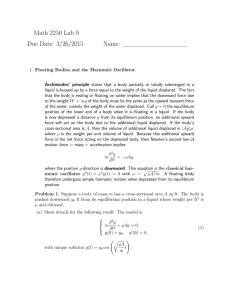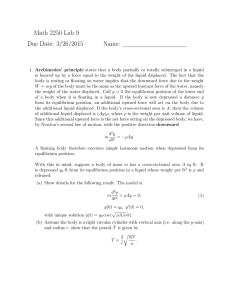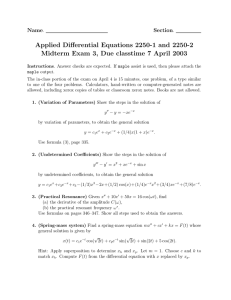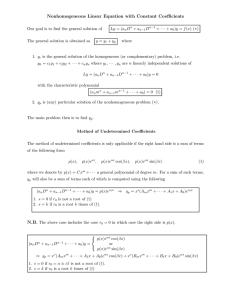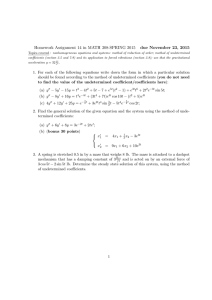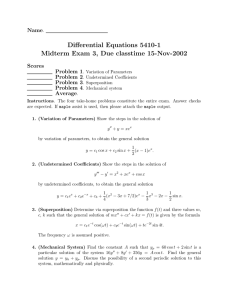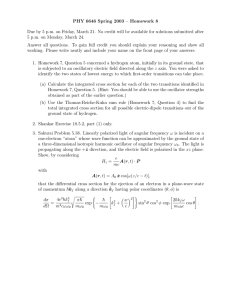Math 2250 Lab 9 Due Date: 3/26/2015 Name:
advertisement
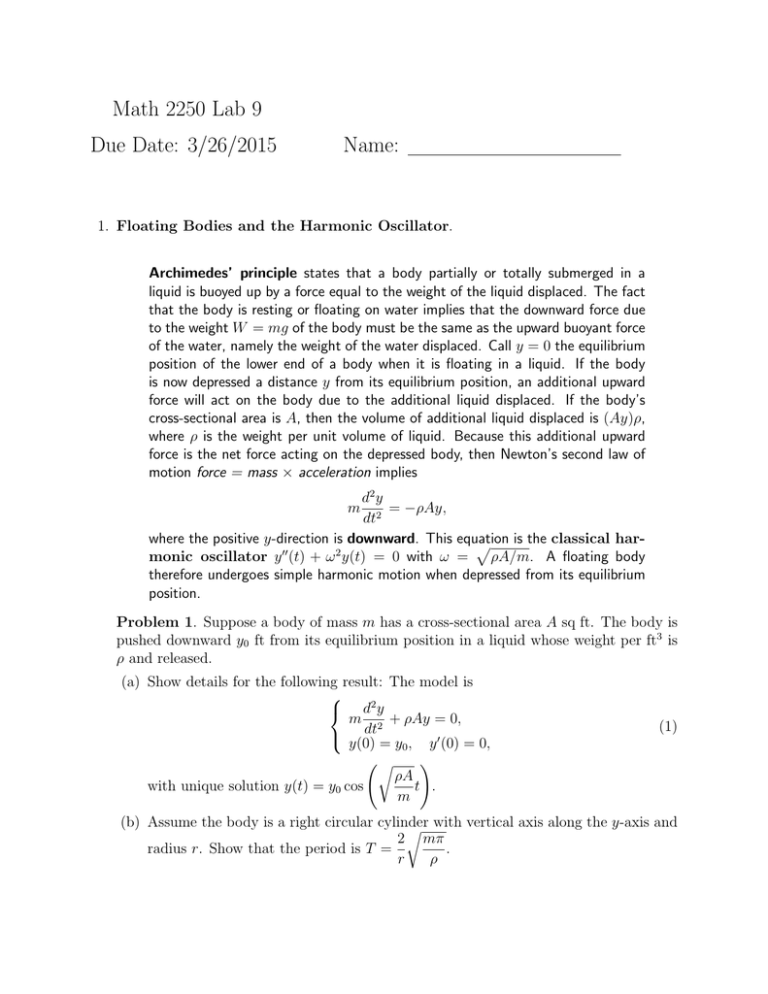
Math 2250 Lab 9 Due Date: 3/26/2015 Name: 1. Floating Bodies and the Harmonic Oscillator. Archimedes’ principle states that a body partially or totally submerged in a liquid is buoyed up by a force equal to the weight of the liquid displaced. The fact that the body is resting or floating on water implies that the downward force due to the weight W = mg of the body must be the same as the upward buoyant force of the water, namely the weight of the water displaced. Call y = 0 the equilibrium position of the lower end of a body when it is floating in a liquid. If the body is now depressed a distance y from its equilibrium position, an additional upward force will act on the body due to the additional liquid displaced. If the body’s cross-sectional area is A, then the volume of additional liquid displaced is (Ay)ρ, where ρ is the weight per unit volume of liquid. Because this additional upward force is the net force acting on the depressed body, then Newton’s second law of motion force = mass × acceleration implies d2 y = −ρAy, dt2 where the positive y-direction is downward. This equation is the classical harp monic oscillator y 00 (t) + ω 2 y(t) = 0 with ω = ρA/m. A floating body therefore undergoes simple harmonic motion when depressed from its equilibrium position. m Problem 1. Suppose a body of mass m has a cross-sectional area A sq ft. The body is pushed downward y0 ft from its equilibrium position in a liquid whose weight per ft3 is ρ and released. (a) Show details for the following result: The model is d2 y m 2 + ρAy = 0, dt y(0) = y0 , y 0 (0) = 0, ! r ρA with unique solution y(t) = y0 cos t . m (1) (b) Assume the body is a right circular cylinder r with vertical axis along the y-axis and 2 mπ radius r. Show that the period is T = . r ρ Page 2 2. The LC-Circuit Equation and the Method of Undetermined Coefficients. R Consider the series RLC circuit in the figure, in which the resistor R has been removed (R = 0 assumed). V L C Assumed are zero initial charge Q(0) = 0 and zero initial current Q0 (0) = 0. Suppose a periodic voltage source V0 cos(ωt) is applied to the circuit. Using Kirchoff’s laws, the following initial value problem gives the charge Q(t) on the capacitor. 1 L · Q00 (t) + R · Q0 (t) + · Q(t) = V0 cos(ωt), C Q(0) = 0, Q0 (0) = 0. Take L = 1 V · s · A−1 , R = 0 Ω, C −1 = 0.25 V · C−1 , and V0 = 4 V. The left sides of these equations define symbols L, R, C, V0 using physical units V =volts, s=seconds, A=amperes, Ω=ohms, C=coulombs. Angular frequency is the coefficient ω0 in trigonometry terms such as cos(ω0 t), cos(ω0 t − α), sin(ω0 t), sin(ω0 t − α). Angular frequency (natural frequency) may differ from references to frequency used in physics and engineering courses. (a) Find the angular frequency ω0 of this system, by determing the angular frequency ω0 of solutions to the unforced equation L · Q00 (t) + R · Q0 (t) + 1 · Q(t) = 0. C (b) Assume that ω 6= ω0 . Let symbol QH (t) be the solution to the homogeneous equation, containing arbitrary constants c1 , c2 . Use the method of undetermined coefficients to solve for a particular solution QP (t). Then use Q(t) = QP (t) + QH (t) to solve the initial value problem for Q(t) (evaluate c1 , c2 using Q(0) = Q0 (0) = 0). Check the answer Q(t) with technology. (c) Write down the solution Q(t) found in part b) for ω = 0.6, which is a superposition of two cosine functions. Compute the period of this solution. Use technology to graph Q(t) for one period. (d) Now let ω = ω0 . Use the method of undetermined coefficients to solve for a new particular solution QP (t). Then use Q(t) = QP (t) + QH (t) to solve the initial value problem for Q(t). (e) The phenomenon of Beats and the phenomenon of Pure Resonance appear in the solutions obtained above. Explain fully. Page 3 Page 4
